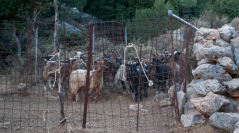

 Anthropozoologica
59 (6) - Pages 77-95
Anthropozoologica
59 (6) - Pages 77-95Populations of feral goats Capra hircus Linnaeus, 1758, descended from escaped or released domesticates, are widespread in the islands of Greece. Although they behave like truly wild goats, many of these animals belong to someone and are exploited by their owner(s) primarily as a source of low-cost but high-value meat. While poachers also kill some of these animals for domestic consumption, many owners capture larger groups alive in traps or drives and then release most females but retain most males for sale to urban butchers. Apart from the status of many feral goats as private property, the distinction between such animals and nearby domestic herds is often obscured by the escape or release of domesticates, by the capture and taming of feral individuals, and by the provision of water and perhaps fodder to discourage feral groups from dispersing. Using information from interviews with herders and trappers, supplemented by first-hand observations, we first describe the formation, behaviour and management of recent feral goat populations on the southern Greek islands of Crete, Kythera and Proti. Although the radical changes in rural demography and land use of recent decades have facilitated the expansion of feral goat populations, the mass capture of these animals by trapping or driving is clearly not a recent innovation. We then discuss possible lessons from these observations for the formation of feral populations and for the management of wild, feral and domestic goats in prehistory.
Private ownership, trapping, driving, prehistoric Mediterranean.